This article was co-authored by Doug Ludemann. Doug Ludemann is the owner and operator of Fish Geeks, LLC, an aquarium services company based in Minneapolis, Minnesota. Doug has worked in the aquarium and fish-care industry for over 20 years, including having worked as a professional aquarist for the Minnesota Zoo and Shedd Aquarium in Chicago. He received his Bachelor of Science in Ecology, Evolution, and Behavior from the University of Minnesota.
wikiHow marks an article as reader-approved once it receives enough positive feedback. This article received 20 testimonials and 100% of readers who voted found it helpful, earning it our reader-approved status.
This article has been viewed 533,520 times.
Aquariums are a lovely addition to any space, creating a lively focal point and a source of color and entertainment. However, more than just something interesting to look at, a tropical freshwater aquarium houses living creatures, and therefore needs to be set up and cared for properly. By choosing a good location, filling the tank, adjusting the water, and adding fish slowly, you can have a beautiful aquarium full of happy and healthy fish in your home.
Steps
Choosing the Right Location
-
1Choose a sturdy benchtop or aquarium stand to support your tank. While some tanks come with bases that are designed to support their weight, standalone tanks will need somewhere sturdy to sit. Find an empty table, bench, or another spot that will be able to hold your tank while it is full of water.[1]
- 1 litre (34 fl oz) of water weighs 1 kilogram (35 oz). In a big tank, this can add up quickly to become very heavy. Make sure that your tank will be properly supported and that you won’t need to move it once it’s full of water.
- If you don’t have anywhere to place your aquarium, you can purchase an aquarium stand online of from your local pet store that will be able to support the tank.
-
2Keep the tank away from direct sunlight, cold breezes, or vibrations. Tropical fish are very sensitive to temperature and noise, so their tank should be safe from anything that might disrupt them. Place the tank in a location that won’t get a lot of direct sun or wind from open windows. The tank should also be far away from any speakers that may cause harsh vibrations.[2]
- Keeping the aquarium in the corner of a room should help avoid many of these potential issues. This will also reduce the chance of the tank getting knocked over by accident.
Advertisement -
3Make sure there are electrical sockets nearby. Your tank will need to have a heater, a filter, and a light, which will all require a nearby electrical socket. When choosing a location for your tank, check that there are adequate power sockets nearby to avoid having to run extension cables all over the place.[3]
- You should also ensure that there’s no chance of any cords coming from the aquarium’s heater or filter being pulled out by young children or excitable pets. Keep the cords tucked away to ensure they are always plugged in.
-
4Place the tank out of reach of other pets. If you have a cat or dog, they may be fascinated by the aquarium and the wildlife inside. Even though your aquarium will have a lid on it, some ambitious animals may try and get inside to catch the fish. Find somewhere to place the tank that will reduce the chances of any curious creatures from getting inside.
- Keeping your aquarium on a sturdy surface high off the ground will reduce the chances of pets disrupting it.
- If you have cats, you may also need another barricade to keep your cats from getting into the tank. Alternately, make sure there aren't any other surfaces nearby that your cat could climb or jump off of to get to the tank.
Filling the Tank
-
1Put down a 5 to 10 cm (2.0 to 3.9 in) layer of rinsed aquarium gravel. Purchase a bag of aquarium gravel or another substrate material from your local pet store. Rinse the gravel with clean water in a bucket or pasta strainer, before scooping it into the tank. Start with 5 centimetres (2.0 in) near the front, sloping up to around 10 centimetres (3.9 in) nearer the back.[4]
- Use a scoop or small trowel to add gravel to your tank rather than pouring it in, as this will reduce the chances of you scratching, damaging, or weakening the tank’s glass.
- Aquarium gravel or other substrates should be available from your local pet store or online.
-
2Fill the tank with water. Place a small dish or bowl on the gravel near the bottom of your tank. Use a hose, small bucket, or large jug to begin adding water to the tank. Pour the water directly onto the dish or bowl, so that it can flow more softly into the tank and not disturb the gravel.[5]
- Leave around 5 centimetres (2.0 in) of space at the top of the tank. This will stop the water from overflowing when you add plants or other decorations.
- The water in your tank will need to be dechlorinated. You could use filtered or bottled water to fill it up or use tap water that has been treated with a dechlorinator. Dechlorination tablets should be available online or from your local pet store.
-
3Add some plants to the aquarium. These can help oxygenate the water and give your tank a more natural look. Purchase some live or artificial aquarium plants from your local pet store and place their roots into the gravel to plant them.[6]
- Most aquariums will have the taller plants nearer the back and some shorter plants in the front.
- Some great aquarium plants could be java moss near the front, water wisteria near the middle, and an aponogeton ulvaceus bulb near the back.
-
4Spruce the tank up with a few decorations. Some colorful artificial decorations, such as a small shipwreck or a few larger rocks, can help break your tank up and give your fish somewhere to be alone. Add 1 or 2 bulkier decorations near the sides of your tank to make it look more interesting.[7]
- Leave roughly 1/3 of the tank empty for your fish to swim around in freely. They should be able to interact with or hide in the decorations when they want to, without being overcrowded by other things in the tank.
- Decorations for your tank could include some larger and well-washed rocks, toy shipwrecks, or almost anything else that you want to put in. See what ideas you can come up with!
- Avoid putting plastic, ceramic, loose driftwood, or glass in the tank. The plastic and ceramic can leach chemicals if left in water over time. Driftwood that hasn't been properly treated may be home to some harmful bacteria, and glass may hurt your fish.
- If you're unsure about a possible decoration for your tank, look online or ask at your local pet store for more advice.
Adjusting the Water
-
1Treat the water for chlorine. The small amounts of chlorine found in most tap water will be dangerous to any fish you add to the aquarium. To prevent any fish from getting ill, treat the water with a tap water conditioner to get rid of the chlorine. Follow the manufacturer’s instructions on your conditioner for the best results.
- Tap water conditioners should be available online or from your local pet store.
-
2Insert a water filter into the tank. The water filter will help get rid of contaminants in your tank’s water and keep it clean and clear. Purchase a water tank filter online or from your local pet store and follow the manufacturer’s instructions to install it in your aquarium.[8]
- There are many, many different types of filters that you can install to keep your aquarium clean and clear. Do some research on different filters for different tank sizes, systems, and price ranges to help determine which is right for your needs.
-
3Add a heater and thermometer to regulate the temperature. Tropical fish will normally require warmer water to thrive in, so a heater and a thermometer are essential. Attach an aquarium heater to the back of your tank and plug it in to begin warming the water. Stick a thermometer onto the front of the glass to keep an eye on the temperature and adjust the heater accordingly.[9]
- Make sure that your heater is installed with a drip loop. This is a small loop or dip in the cable just before it plugs into the wall socket. The drip loop will allow water to run down the cable and drip off the bottom of the loop rather than running into your electrical socket.
- The required temperature for your aquarium will depend on the fish you want to keep in it. Research the comfortable temperature for each fish before you purchase it to make sure it can thrive in your aquarium.
- Don’t plug the heater in for 30 minutes after you put it into the tank. Otherwise, the sudden shift in temperature may cause your heater to shatter.
-
4Test your water to make sure it’s safe for fish. There are many factors of water that can make it unsafe for fish, such as the pH level or the level of ammonia. Purchase an aquarium water test kit and follow the manufacturer’s instructions to test the water. Here are some things you should be looking out for:
- The pH level of your aquarium should be between 6.0 and 8.0. If it's too low, raise the pH of your fish tank, such as by adding baking soda. If it's too high, lower the pH of your fish tank, like by adding driftwood.
- The ammonia, nitrate, and nitrite levels will all be managed naturally over time. However, no fish should be added until there is no ammonia or nitrite in the tank, and you begin to get a reading for nitrate.
- You should test the water at least once each month to ensure it is safe.
-
5Place the hood and tank light over the aquarium. The hood will stop anything unwanted from getting into the aquarium, and the lamp will help the live plants in your tank thrive. If your hood doesn’t have a lamp included, purchase an 18- to 40-watt aquarium lamp online or from your local pet store.[10]
- Make sure your lamp is also plugged in with a drip loop to reduce the chance of electrocution or electrical failure.
- If you are keeping live plants in your tank, you’ll need at least 1 watt for every 1 litre (34 fl oz) in your tank. Otherwise, any lamp between 18- and 40-watts will work.
- Keep the lamp on a timer so that it is only on for 10 to 12 hours each day. Leaving it on for any longer than this can increase the temperature, rates of water evaporation, and algae growth. Light timers should be available from your local hardware or electronics store. Some pet stores may also have them.
-
6Do a fishless cycle to build up bacteria in the filter. There are many bacteria that need to build up in your fish tank before it will be safe for fish to swim in it. Leave the filter to cycle for between 2 days and up to 1 week in order to build up the bacteria in your filter. Continue cycling your tank until the water is safe for fish.[11]
- To make this process go faster, add a small sprinkle of fish food to your tank, or ask your local pet store for some gravel or a dirty filter pad with plenty of good bacteria already on it.
- The water in your tank will need to have very low levels of ammonia and nitrites in order to be safe. You should just begin to see nitrates being produced when the water becomes safe.
Adding Fish to the Tank
-
1Choose 1 or 2 tropical fish to begin with. Adding too many fish to the water at once can throw off the balance of ammonia, nitrates, and bacteria that you’ve built up. Choose 1 or 2 tropical fish that are easy to care for to start off your new aquarium.[12]
- African cichlids and neon tetras make for great first fish in your tropical aquarium. If you can’t find any at your local pet store, talk to an employee to see if they have any recommendations of a first tropical fish to buy.
- Whichever fish you buy, make sure you research the elements they require from a tank to check that you can keep them happy and healthy.
- It's easiest to start with 2 fish of the same species if you're setting up an aquarium for the first time.
- Make sure that the fish you choose are compatible with each other! Some fish will attack, stress, or even eat other species of fish. Look online or ask at your local pet store when adding new fish to your tank.
-
2Turn off the lights in the aquarium. Bright lights in the tank when your fish are first introduced will likely stress them out and make them take longer to adjust to their new home. Turn off the lamp in your tank, and make sure there are plenty of hiding places so your fish can adjust to swimming around at their own pace.[13]
- You can turn the lamp back onto its regular timer once the fish have adjusted to the tank and are swimming around by themselves.
- If your fish are stressed out, they may become sick and die more easily. Anything you can do to reduce their stress will only make them happier and healthier.
-
3Let the fish acclimate to the water before adding them to the tank. Float the plastic bag that your new fish came in on top of your aquarium to equalize the temperatures. After 20 minutes or so, add water from the tank to the bag to double the amount of water the fish can swim in. Wait another 20 minutes before scooping the fish out of the bag and into the tank with a net.[14]
- Pouring the fish straight into new water will shock them, which can be detrimental to their health. This will help them adjust to the water in the tank slowly.
- Avoid mixing water from the bag into the water in the tank, as this can be detrimental to the tank water.
- Don’t feed your fish on their first day in the tank. They’ll likely be too stressed to eat, so the food will sink to the bottom and rot. Feed them every other day for 4 to 6 weeks after this, before changing to the recommended feeding schedule for your fish.
-
4Watch the fish for signs of illness. Keep an eye on your fish over the next few days to make sure they are adjusting to the aquarium properly. If your fish seems inactive or slow-moving, check that they aren’t ill and treat them properly if they seem unwell.[15]
- There are many different indicators that your fish may be stressed or unwell. If they are not eating, spending a lot of time near the surface, sticking to the bottom of the tank, or not eating, it could be a sign that something is wrong.
- Keep an eye on your fish's skin as well. Any changes, tears, or colored spots could be a sign that your fish is ill and needs to be treated for a new illness.
-
5Test the water every day for at least 1 month. As your fish begin living in the tank, eating food, and producing waste, they may begin throwing off the balance of your aquarium. Test the water in your tank every 1 or 2 days to make sure the pH level stays the same, and the ammonia levels don’t begin to rise.[16]
- Raise and lower the pH of your fish tank as you need to to keep it within the comfortable range for your fish.
- If you notice the levels of ammonia creeping up in your fish tank, change the water and avoid over-feeding your fish to lower ammonia levels in the tank.
- Most water testing kits will have indicator strips that you can either dip into the water or drop water onto, with the indicators changing colors depending on levels. Check the manufacturer's instruction for more specific advice on how to use and read the indicators in your own set.
-
6Add more fish after 4 to 6 weeks. You should give your first few fish plenty of time to adjust to their new home before adding any more fish to the tank. Begin adding new fish to the aquarium after 4 to 6 weeks if you want to, making sure that every fish can live comfortably together and that they are added to the tank safely.
- There are many different reasons that different species of fish won’t be able to live together. Make sure that your fish are compatible before adding them to the same tank.
Expert Q&A
Did you know you can get expert answers for this article?
Unlock expert answers by supporting wikiHow
-
QuestionHow long does it take for tap water to be safe for fish?
 Doug LudemannDoug Ludemann is the owner and operator of Fish Geeks, LLC, an aquarium services company based in Minneapolis, Minnesota. Doug has worked in the aquarium and fish-care industry for over 20 years, including having worked as a professional aquarist for the Minnesota Zoo and Shedd Aquarium in Chicago. He received his Bachelor of Science in Ecology, Evolution, and Behavior from the University of Minnesota.
Doug LudemannDoug Ludemann is the owner and operator of Fish Geeks, LLC, an aquarium services company based in Minneapolis, Minnesota. Doug has worked in the aquarium and fish-care industry for over 20 years, including having worked as a professional aquarist for the Minnesota Zoo and Shedd Aquarium in Chicago. He received his Bachelor of Science in Ecology, Evolution, and Behavior from the University of Minnesota.
Professional Aquarist
-
QuestionCan rocks be used that are from tropical fish tanks?
 Community AnswerIt depends on what kind of rocks they are. If they are slate, that is perfectly fine, but it takes longer to cycle the tank. If they are rocks other than slate, do some research to be sure they are safe for aquarium use.
Community AnswerIt depends on what kind of rocks they are. If they are slate, that is perfectly fine, but it takes longer to cycle the tank. If they are rocks other than slate, do some research to be sure they are safe for aquarium use. -
QuestionCan I add a heater to a tank that's already established as a hold water tank?
 Dieyun DingTop AnswererYes, you can, if you're planning to hold tropical fish instead of cold water fish.
Dieyun DingTop AnswererYes, you can, if you're planning to hold tropical fish instead of cold water fish.
Warnings
- Make sure all electrical cords are installed with a loop that water can drip off of. Known as a drip loop, this will stop water from running down the cord and into an electrical socket.⧼thumbs_response⧽
- Do not turn the heater in your tank on until it has plenty of time to adjust to the water temperature. Leave it in the water for 30 minutes before plugging it in to prevent it from shattering.⧼thumbs_response⧽
Things You'll Need
- Aquarium
- Aquarium stand (optional)
- Gravel
- Scoop or small trowel
- Water bucket or hose
- Water conditioner
- Aquarium decorations
- Aquarium plants
- Water filter
- Heater
- Tank thermometer
- Water test kit
- Tank hood and light
- Lamp timer (optional)
References
- ↑ https://www.fishlore.com/FirstTankSetup.htm
- ↑ https://www.fishlore.com/FirstTankSetup.htm
- ↑ https://www.fishlore.com/FirstTankSetup.htm
- ↑ http://www.tropicalfishcentre.co.uk/Setting.htm
- ↑ https://www.fishlore.com/FirstTankSetup.htm
- ↑ https://www.fishlore.com/FirstTankSetup.htm
- ↑ https://www.fishlore.com/FirstTankSetup.htm
- ↑ https://www.fishlore.com/FirstTankSetup.htm
- ↑ https://www.fishlore.com/FirstTankSetup.htm
- ↑ https://www.fishlore.com/aquarium_light.htm
- ↑ https://www.fishlore.com/FirstTankSetup.htm
- ↑ https://www.fishlore.com/FirstTankSetup.htm
- ↑ https://www.fishlore.com/acclimating-tropicalfish.htm
- ↑ https://www.fishlore.com/acclimating-tropicalfish.htm
- ↑ https://modestfish.com/fish-disease-guide/
- ↑ https://www.fishlore.com/FirstTankSetup.htm
About This Article
To set up a tropical freshwater aquarium, start by lining the bottom of a tank with 2-4 inches of rinsed aquarium gravel. Then, fill the tank with dechlorinated water, and add some live plants and decorations. Next, install a filter to keep the water clean, and hook up a heater and thermometer so you can keep the water at a warm enough temperature for tropical fish. Finally, before you add any tropical fish to your tank, do a fishless cycle to build up bacteria in the filter. To learn how to add fish to your tank, scroll down!

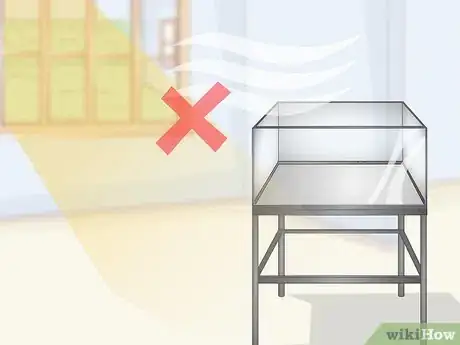



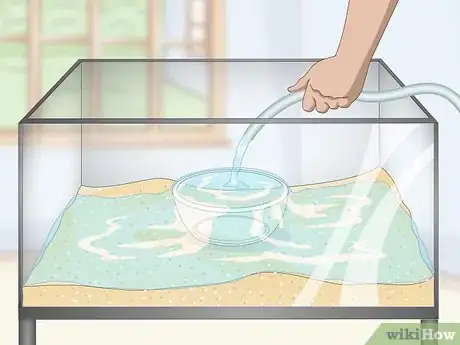
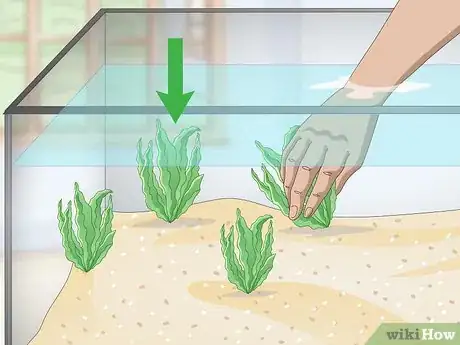
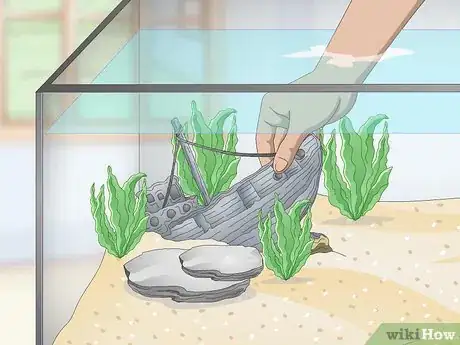
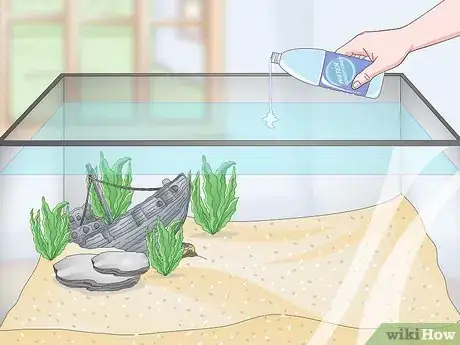
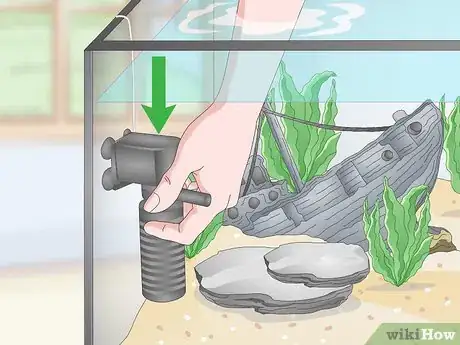
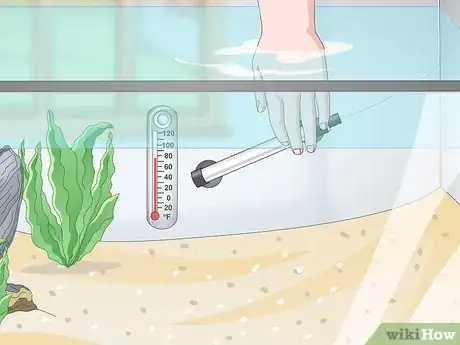
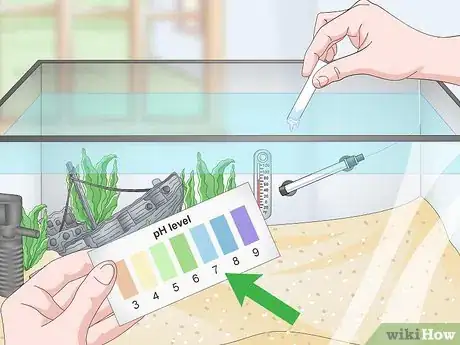
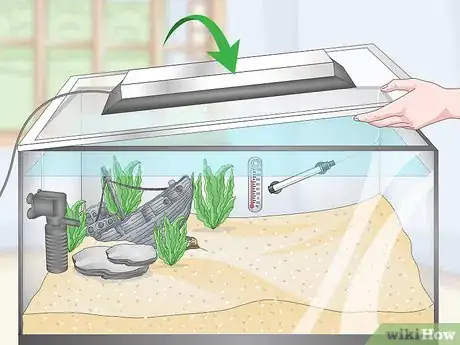
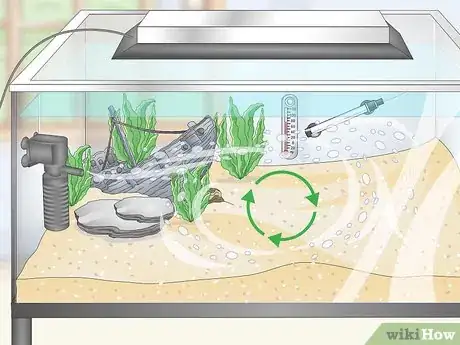

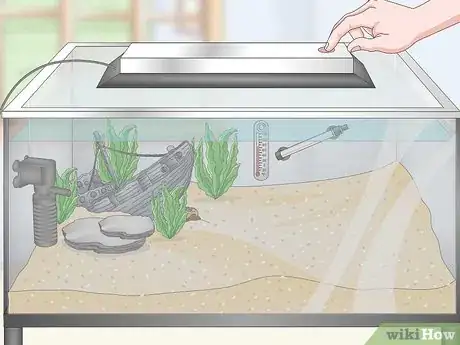
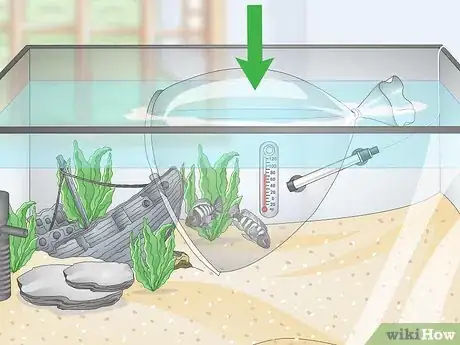
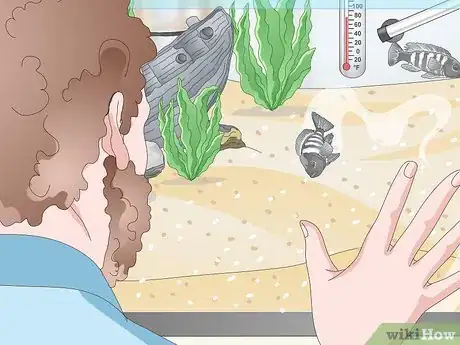


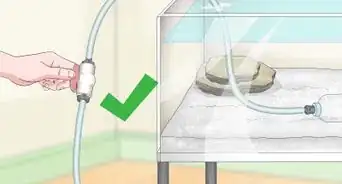

-Step-10-Version-2.webp)
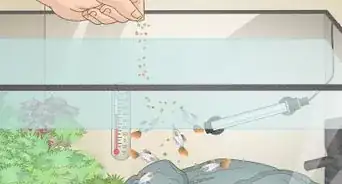




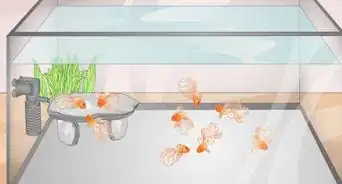
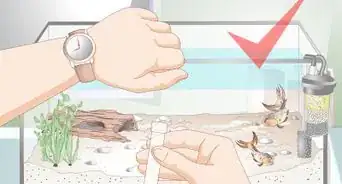















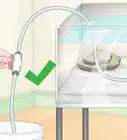

-Step-10-Version-2.webp)



































